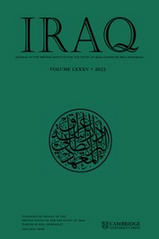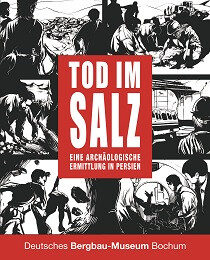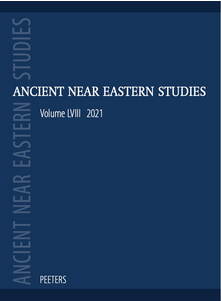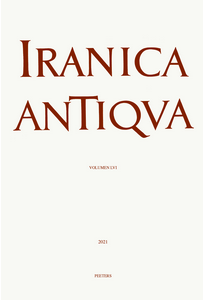Publications so far
0
| 1. |  | Amelirad, Sheler; Razmpoush, Abbas; Khanmohamadi, Behroz: Kani Charmou, an Iron Age II graveyard. In: Iraq, vol. 85, pp. 49-71, 2024. (Type: Journal Article | Abstract | Links | BibTeX)@article{nokey,Examining the archaeological findings within the Mannaean kingdom, a significant association with Assyria emerges, highlighting these regions’ interconnectedness. The influence of both Urartian and Assyrian cultures on the Mannaean people becomes evident, indicating a shared cultural heritage or intimate exchanges among these cultures. Notably, the Kani Charmou graveyard in Mannaea serves as a compelling example, revealing a rich assortment of artifacts that parallel those discovered in Ziwiye, a renowned archaeological site in the region. These diverse grave goods unequivocally demonstrate the existence of a robust trade and exchange network between Mannaea and its neighbouring western counterpart, Assyria, and the profound impact of Assyrian culture on Mannaean society. This connection is also evident in religious practices, which show similarities. Through stylistic analysis and the identification of parallels in metal vessels, glazed jars, and a cylinder seal, the proposed dating of the Kani Charmou graveyard aligns with the Iron Age II period. |
| 2. |  | Stöllner, Thomas; Aali, Abolfazl: Long-Term Salt Mining in Chehrābād: Resilient Strategies in Accessing Mineral Resources at the Iranian Highlands. In: Pearls, Politics and Pistachios: Essays in Anthropology and Memories on the Occasion of Susan Pollock’s 65th Birthday, pp. 352-369, Ex Oriente/Propylaeum, Berlin/Heidelberg, 2021. (Type: Book Chapter | Links | BibTeX)@inbook{nokey, |
| 3. |  | Stöllner, Thomas; Aali, Abolfazl; Kashani, Natascha Bagherpour (Ed.): Tod im Salz. Eine archäologische Ermittlung in Persien. Nünnerich-Asmus Verlag & Media GmbH, 2020, ISBN: 978-3-96176-141-8. (Type: Book | Abstract | Links | BibTeX)@book{nokey,Since the first discoveries in 1993 bodies or body-parts of eight humans have been discovered at the salt-mine of Douzlākh at Chehrābād. These bodies allow a reconstruction of their lives as workers during the different operation periods. By involving many different scientific fields, it became possible to investigate their palaeo-medical aspects, their diet and their health status as well the causes of their death and their involvement into different aspects of the mining operation and logistics of the mine. It is possible not only to reconstruct three different catastrophes during the Achaemenid, the early and the late Sasanian times but also to understand the social aspects of the working people. The Achaemenid miners certainly came from abroad but already stayed a while in the region, apart from the young miner no. 4 who seems to have arrived shortly before the catastrophe. This group of migrants possibly were sent within a “bandaka”, an Achaemenid labour duty. The Sassanian miners partly came from a “regional” background but also came shortly before their deaths. Saltman 1 is interesting as he is an older individual who possibly had a special role within the miners. Mining at Douzlakh was predominantly operated in periods of strong centralized political systems when governmental activities could be organized over longer distances. |
| 4. |  | Maziar, Sepideh; Zalaghi, Ali: Exploring Beyond the River and Inside the Valleys: Settlement Development and Cultural Landscape of the Araxes River Basin Through Time. In: Iran, iss. 59, pp. 36–56, 2020. (Type: Journal Article | Abstract | Links | BibTeX)@article{nokey,Geographical landmarks, especially rivers, have always played an important role in forming or hampering interplay between societies. In some cases, they act as a “communication route” and in some others as “obstacles”. In north-western Iran, it is possible that the Araxes River played such a decisive role by sculpting its surroundings. While our studies are not yet sufficiently adequate to understand the exact role of this river in different time spans, we can begin in some way to conceptualise its role in different periods. The Araxes Valley Archaeological Project (AVAP) was developed with the general aim of investigating settlement development from the fifth to the third millennium BC. Furthermore, studying the possible and probable routes of interaction, both inter- and intra-regional, between the Jolfa and Khoda Afarin plains and the southern Caucasus and north-western Iran, networks of contacts and exchange, and gaining a better understanding of the geographical characteristics of this area and its landscape were among our aims. In this article, the general history of occupation along this river is given to provide a preliminary database to understand the geographical and socio-political potential of this part in order to pursue more comprehensive studies in the future. |
| 5. |  | Amelirad, Sheler; Azizi, Eghbal: Kani Koter, Iron Age Cemetery from Iranian Kurdistan. In: Iran, vol. 59, iss. 1, pp. 57-76, 2019. (Type: Journal Article | Abstract | Links | BibTeX)@article{nokey,Kani Koter cemetery is located in Iranian Kurdistan, close to Dere Pemeyan (or Persian Dare Panbedan) village, between the ancient sites of Ziwiye and Karafto Cave (Figure 1). In this article, we discuss the material discovered from one of the graves in this cemetery, its chronology, and cultural associations. Unfortunately, tomb robbers plundered this grave, completely ruining the tomb's stratigraphic context. Fortunately, in 2016 the Cultural Heritage Organization of Kurdistan rescued all of the stolen artefacts, and today the collection is stored at the Sanandaj Museum. The grave has yielded a number of elaborately decorated objects that belong nominally to Assyrian, Urartian and Mannaean artistic traditions, with the date for the finds being established by means of comparisons with Assyrian and Urartian artefacts. |
| 6. |  | Amelirad, Sheler; Mohajerynezhad, Abdolrezer; Javidkhah, Masoume: A Report on the Excavation at the Mala Mcha Graveyard, Kurdistan, Iran. In: Iran, vol. 55, iss. 2, pp. 171-207, 2017. (Type: Journal Article | Abstract | Links | BibTeX)@article{nokey,The Mala Mcha graveyard is located in Iranian Kurdistan, near the ancient Mannaean site of Ziwiya. Abdolreza Mohajerynezhad and Rasol Oshtodan conducted rescue excavations at Mala Mcha in 2012, and 16 graves were uncovered. Although most of the graves had been plundered by tomb robbers the tomb structures, and especially the grave-goods that remained, suggest an Iron Age III date and close relations with neighbouring sites such as Ziwiye, Qalaichi and Changbar. Most of the graves were covered with large flat slabs and contained one, two or three burials, the exception being tomb no. 7 with 14 burials. |
| 7. |  | Amelirad, Sheler; Razmpoush, Abbas: A Newly Discovered Iron Age Site at Sarrez, Iranian Kurdistan. In: Ancient Near Eastern Studies, vol. 52, pp. 207-216, 2015. (Type: Journal Article | Abstract | Links | BibTeX)@article{nokey,Sarrez is an ancient site in Kurdistan Province, Iran, near the present-day country town of Kamyaran. This site was discovered accidentally during dam construction activities. It has yielded some metal artefacts, potsherds and bones that are comparable to Iron Age III instances. The collection in its entirety is discussed in this article. One of the main objects from Sarrez is a decorated beaker with a scene on its wall that is comparable in many ways to examples of Neo-Assyrian art. The purpose of this paper is to publish and date the metal objects of the Sarrez collection based on this bronze beaker, which is one the few beakers from western Iran which has been found in a secure context. |
| 8. |  | Amelirad, Sheler; Overlaet, Bruno; Haerinck, Ernie: The Iron Age “Zagros Graveyard” Near Sanandaj (Iranian Kurdistan): Preliminary Report on the First Season. In: Iranica Antiqua, vol. 47, pp. 41-99, 2012. (Type: Journal Article | Abstract | Links | BibTeX)@article{nokey,An Iron Age graveyard, for the most part dating from the 8th - 7th century BC, was accidentally discovered in 2008 during road works near Sanandaj, Iranian Kurdistan. Rescue excavations were conducted by the Cultural Heritage Department in Sanandaj. The present contribution reports on these first excavations during which more than 20 graves were discovered in two squares and a trench. A selection of the graves and the burial goods are discussed. |
| 9. |  | Pigott, Vincent Charles: The question of the presence of iron in the iron I period in Western Iran. In: Bibliotheca Mesopotamica, vol. 7, pp. 210-234, 1977. (Type: Journal Article | Abstract | BibTeX)@article{nokey,Archaeological considerations of cultural patterning within the Iron I period have centered primarily on ceramic investigations. The intent of this investigation is to add information on another dimension of our archaeological understanding of the Iron I period, namely the evidence for metallic iron and its associated metallurgy. For significantly it is within the final stages of the lron I period that artifacts of wrought iron first began to appear in excavated context in westem Iran. Data will be made evident by plotting the site by site distribution of iron artifacts by quantity and type from the period. (See fig. 1 for map of excavated sites in westem Iran with known Iran I contexts.) At the same time an attempt will be made to ascertain the significance of these artifacts within the cultural contexts from which they derive. |
| 10. | Pigott, Vincent Charles: The Question of the Presence of Iron in the Iron I Period in Western Iran. In: Levine, Louis D. (Ed.): Mountains and Lowlands. Essays in the Archaeology of Greater Mesopotamia
, pp. 209-234, Undena Publications, 1977. (Type: Book Section | BibTeX)@incollection{nokey, | |
| 11. | Pleiner, Radomír: The Beginnings of the Iron Age in Ancient Persia. In: Annals of the Náprstek Museum, vol. 6, no. 1, pp. 9–72, 1967. (Type: Journal Article | Links | BibTeX)@article{nokey, |
2024 |
|
 | Amelirad, Sheler; Razmpoush, Abbas; Khanmohamadi, Behroz: Kani Charmou, an Iron Age II graveyard. In: Iraq, vol. 85, pp. 49-71, 2024. (Type: Journal Article | Abstract | Links | BibTeX | Tags: Iron, Iron Age, Kurdistan, Zagros, Zagros Highlands)@article{nokey,Examining the archaeological findings within the Mannaean kingdom, a significant association with Assyria emerges, highlighting these regions’ interconnectedness. The influence of both Urartian and Assyrian cultures on the Mannaean people becomes evident, indicating a shared cultural heritage or intimate exchanges among these cultures. Notably, the Kani Charmou graveyard in Mannaea serves as a compelling example, revealing a rich assortment of artifacts that parallel those discovered in Ziwiye, a renowned archaeological site in the region. These diverse grave goods unequivocally demonstrate the existence of a robust trade and exchange network between Mannaea and its neighbouring western counterpart, Assyria, and the profound impact of Assyrian culture on Mannaean society. This connection is also evident in religious practices, which show similarities. Through stylistic analysis and the identification of parallels in metal vessels, glazed jars, and a cylinder seal, the proposed dating of the Kani Charmou graveyard aligns with the Iron Age II period. |
2021 |
|
 | Stöllner, Thomas; Aali, Abolfazl: Long-Term Salt Mining in Chehrābād: Resilient Strategies in Accessing Mineral Resources at the Iranian Highlands. In: Pearls, Politics and Pistachios: Essays in Anthropology and Memories on the Occasion of Susan Pollock’s 65th Birthday, pp. 352-369, Ex Oriente/Propylaeum, Berlin/Heidelberg, 2021. (Type: Book Chapter | Links | BibTeX | Tags: Achaemenid, Administration, Bronze Age, Chalcolithic, Institutions, Iron Age, Islamic era, Minerals, Mining, Neolithic, Resilience, Resources, Salt, Sasanian, Zanjan)@inbook{nokey, |
2020 |
|
 | Stöllner, Thomas; Aali, Abolfazl; Kashani, Natascha Bagherpour (Ed.): Tod im Salz. Eine archäologische Ermittlung in Persien. Nünnerich-Asmus Verlag & Media GmbH, 2020, ISBN: 978-3-96176-141-8. (Type: Book | Abstract | Links | BibTeX | Tags: Achaemenid, Administration, Bronze Age, Chalcolithic, Institutions, Iron Age, Islamic era, Minerals, Mining, Mobility, Neolithic, Salt, Sasanian, Zanjan)@book{nokey,Since the first discoveries in 1993 bodies or body-parts of eight humans have been discovered at the salt-mine of Douzlākh at Chehrābād. These bodies allow a reconstruction of their lives as workers during the different operation periods. By involving many different scientific fields, it became possible to investigate their palaeo-medical aspects, their diet and their health status as well the causes of their death and their involvement into different aspects of the mining operation and logistics of the mine. It is possible not only to reconstruct three different catastrophes during the Achaemenid, the early and the late Sasanian times but also to understand the social aspects of the working people. The Achaemenid miners certainly came from abroad but already stayed a while in the region, apart from the young miner no. 4 who seems to have arrived shortly before the catastrophe. This group of migrants possibly were sent within a “bandaka”, an Achaemenid labour duty. The Sassanian miners partly came from a “regional” background but also came shortly before their deaths. Saltman 1 is interesting as he is an older individual who possibly had a special role within the miners. Mining at Douzlakh was predominantly operated in periods of strong centralized political systems when governmental activities could be organized over longer distances. |
 | Maziar, Sepideh; Zalaghi, Ali: Exploring Beyond the River and Inside the Valleys: Settlement Development and Cultural Landscape of the Araxes River Basin Through Time. In: Iran, iss. 59, pp. 36–56, 2020. (Type: Journal Article | Abstract | Links | BibTeX | Tags: Armenia, Azerbaijan, Bronze Age, Caucasus, Chalcolithic, Georgia, Iron Age, Kura-Araxes, Landscape, Mobility, Neolithic, Settlement and subsistance systems, Settlement mobility, Settlement structure, Structure development)@article{nokey,Geographical landmarks, especially rivers, have always played an important role in forming or hampering interplay between societies. In some cases, they act as a “communication route” and in some others as “obstacles”. In north-western Iran, it is possible that the Araxes River played such a decisive role by sculpting its surroundings. While our studies are not yet sufficiently adequate to understand the exact role of this river in different time spans, we can begin in some way to conceptualise its role in different periods. The Araxes Valley Archaeological Project (AVAP) was developed with the general aim of investigating settlement development from the fifth to the third millennium BC. Furthermore, studying the possible and probable routes of interaction, both inter- and intra-regional, between the Jolfa and Khoda Afarin plains and the southern Caucasus and north-western Iran, networks of contacts and exchange, and gaining a better understanding of the geographical characteristics of this area and its landscape were among our aims. In this article, the general history of occupation along this river is given to provide a preliminary database to understand the geographical and socio-political potential of this part in order to pursue more comprehensive studies in the future. |
2019 |
|
 | Amelirad, Sheler; Azizi, Eghbal: Kani Koter, Iron Age Cemetery from Iranian Kurdistan. In: Iran, vol. 59, iss. 1, pp. 57-76, 2019. (Type: Journal Article | Abstract | Links | BibTeX | Tags: Chronology, Iron Age, Kurdistan, Material Analysis)@article{nokey,Kani Koter cemetery is located in Iranian Kurdistan, close to Dere Pemeyan (or Persian Dare Panbedan) village, between the ancient sites of Ziwiye and Karafto Cave (Figure 1). In this article, we discuss the material discovered from one of the graves in this cemetery, its chronology, and cultural associations. Unfortunately, tomb robbers plundered this grave, completely ruining the tomb's stratigraphic context. Fortunately, in 2016 the Cultural Heritage Organization of Kurdistan rescued all of the stolen artefacts, and today the collection is stored at the Sanandaj Museum. The grave has yielded a number of elaborately decorated objects that belong nominally to Assyrian, Urartian and Mannaean artistic traditions, with the date for the finds being established by means of comparisons with Assyrian and Urartian artefacts. |
2017 |
|
 | Amelirad, Sheler; Mohajerynezhad, Abdolrezer; Javidkhah, Masoume: A Report on the Excavation at the Mala Mcha Graveyard, Kurdistan, Iran. In: Iran, vol. 55, iss. 2, pp. 171-207, 2017. (Type: Journal Article | Abstract | Links | BibTeX | Tags: Chronology, Excavation, Iron, Iron Age, Kurdistan, Zagros Highlands)@article{nokey,The Mala Mcha graveyard is located in Iranian Kurdistan, near the ancient Mannaean site of Ziwiya. Abdolreza Mohajerynezhad and Rasol Oshtodan conducted rescue excavations at Mala Mcha in 2012, and 16 graves were uncovered. Although most of the graves had been plundered by tomb robbers the tomb structures, and especially the grave-goods that remained, suggest an Iron Age III date and close relations with neighbouring sites such as Ziwiye, Qalaichi and Changbar. Most of the graves were covered with large flat slabs and contained one, two or three burials, the exception being tomb no. 7 with 14 burials. |
2015 |
|
 | Amelirad, Sheler; Razmpoush, Abbas: A Newly Discovered Iron Age Site at Sarrez, Iranian Kurdistan. In: Ancient Near Eastern Studies, vol. 52, pp. 207-216, 2015. (Type: Journal Article | Abstract | Links | BibTeX | Tags: Iron Age, Kurdistan, Material Analysis, Zagros, Zagros Highlands)@article{nokey,Sarrez is an ancient site in Kurdistan Province, Iran, near the present-day country town of Kamyaran. This site was discovered accidentally during dam construction activities. It has yielded some metal artefacts, potsherds and bones that are comparable to Iron Age III instances. The collection in its entirety is discussed in this article. One of the main objects from Sarrez is a decorated beaker with a scene on its wall that is comparable in many ways to examples of Neo-Assyrian art. The purpose of this paper is to publish and date the metal objects of the Sarrez collection based on this bronze beaker, which is one the few beakers from western Iran which has been found in a secure context. |
2012 |
|
 | Amelirad, Sheler; Overlaet, Bruno; Haerinck, Ernie: The Iron Age “Zagros Graveyard” Near Sanandaj (Iranian Kurdistan): Preliminary Report on the First Season. In: Iranica Antiqua, vol. 47, pp. 41-99, 2012. (Type: Journal Article | Abstract | Links | BibTeX | Tags: Ceramics, Chronology, Excavation, Iron, Iron Age, Kurdistan, Pottery, Zagros, Zagros Highlands)@article{nokey,An Iron Age graveyard, for the most part dating from the 8th - 7th century BC, was accidentally discovered in 2008 during road works near Sanandaj, Iranian Kurdistan. Rescue excavations were conducted by the Cultural Heritage Department in Sanandaj. The present contribution reports on these first excavations during which more than 20 graves were discovered in two squares and a trench. A selection of the graves and the burial goods are discussed. |
1977 |
|
 | Pigott, Vincent Charles: The question of the presence of iron in the iron I period in Western Iran. In: Bibliotheca Mesopotamica, vol. 7, pp. 210-234, 1977. (Type: Journal Article | Abstract | BibTeX | Tags: Iron, Iron Age)@article{nokey,Archaeological considerations of cultural patterning within the Iron I period have centered primarily on ceramic investigations. The intent of this investigation is to add information on another dimension of our archaeological understanding of the Iron I period, namely the evidence for metallic iron and its associated metallurgy. For significantly it is within the final stages of the lron I period that artifacts of wrought iron first began to appear in excavated context in westem Iran. Data will be made evident by plotting the site by site distribution of iron artifacts by quantity and type from the period. (See fig. 1 for map of excavated sites in westem Iran with known Iran I contexts.) At the same time an attempt will be made to ascertain the significance of these artifacts within the cultural contexts from which they derive. |
Pigott, Vincent Charles: The Question of the Presence of Iron in the Iron I Period in Western Iran. In: Levine, Louis D. (Ed.): Mountains and Lowlands. Essays in the Archaeology of Greater Mesopotamia
, pp. 209-234, Undena Publications, 1977. (Type: Book Section | BibTeX | Tags: Iron, Iron Age)@incollection{nokey, | |
1967 |
|
Pleiner, Radomír: The Beginnings of the Iron Age in Ancient Persia. In: Annals of the Náprstek Museum, vol. 6, no. 1, pp. 9–72, 1967. (Type: Journal Article | Links | BibTeX | Tags: Iron Age)@article{nokey, | |
